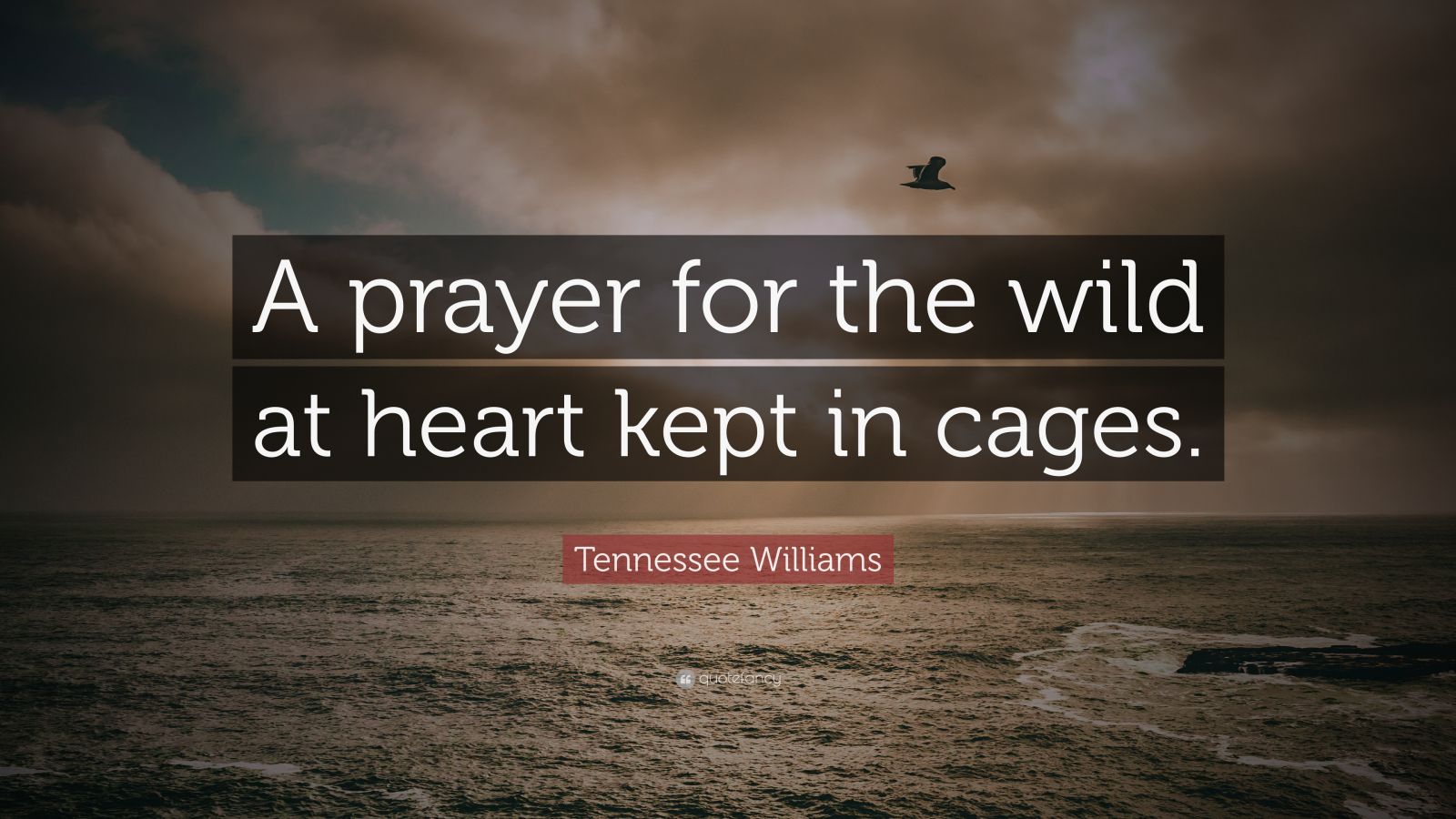
- A prayer for the wild at heart kept in cages movie#
- A prayer for the wild at heart kept in cages portable#
I saw how, as I read play after play, story after story, essay after essay, Williams was building a complete world, a world that told his story in metaphorical forms. When I read Williams I felt he was somehow speaking directly to me-about his fears, his obsessions, his joys, his agonies.


Williams was so completely different from the pulp writers I’d loved in high school-those writers seemed interested in nothing but “telling a story,” and they were certainly entertaining enough, but Williams’ work came from another place, somewhere personal and intimate. I was entranced with the power of his language, the potency of his metaphors. I ate them.Īnd I read Williams-there behind the desk and then back home. I also looked forward eagerly to the arrival of the doughnut man at 6:30-he would bring a big platter of doughnuts for the delectation of the guests.
A prayer for the wild at heart kept in cages portable#
The managers had a tiny black-and-white portable TV behind the desk and I watched it a lot. I checked in a few people each night, but my job was mostly to answer the phone and transfer calls to the rooms as necessary. to 7 a.m.-and the job, such as it was, afforded me ample time for reading there were few customers. I had a part-time job as the overnight desk clerk at a local motel-my “graveyard shift” ran from 11 p.m. I’d gone there for the express purpose of writing-of doing nothing but writing. “I have tricks in my pocket-I have things up my sleeve…”īut whatever that first experience was, I had fallen completely for Williams by the time I was 20 and living on my own in a tiny apartment-it was literally the size of a large closet-in San Luis Obispo, California.

I wasn’t yet sufficiently formed to appreciate and fall in love with the extraordinary language of that play, Tom Wingfield’s monologues which, a few years later, I would study obsessively and ultimately memorize, trying to understand how such writing was done, how anyone could pack such lyricism and poetry and rhythmic intensity into such apparently simple lines. It may have been in a class reading of The Glass Menagerie, Williams’ “nice” play and certainly the only one that, when I was a student, nervous public school officials would ever have dreamt of allowing into the syllabi of their squeaky-clean school districts. I wish I could recall my actual first encounter with Tennessee Williams’ writing. But it doesn’t even begin to approach what made Williams a great writer, or why I responded so strongly to his work. That image is not wrong, in its limited way. From the memories of those films, we get most of the popular image of Tennessee Williams’ work-Southern, sultry, and sexual. Two movies, one mildly revised from the actual play and the other- Cat-massively rewritten.
A prayer for the wild at heart kept in cages movie#
Say the name “Tennessee Williams” and most people will think primarily of the movie of Streetcar Named Desire and Marlon Brando shouting, “STELLA!” If they think for a moment longer they may recall Newman and Taylor’s Cat on a Hot Tin Roof with Burl Ives stalking the halls of a Southern plantation bellowing about mendacity. Maybe one explanation is that Williams is a deeply misunderstood, or perhaps I should say only partially understood, writer.

Yet my reaction to that reaction can only be one of puzzlement. “I wouldn’t have guessed that,” one person said to me not long ago. When I’ve told people that I consider Tennessee Williams perhaps the single most profound influence on me as a writer, the reaction I’ve generally gotten has been one of puzzlement. As it turned out she died just three days shy of Williams’ 100 th birthday-which is today. She also appeared, with Richard Burton, in another Williams film, the unfortunately-titled Boom! of 1968 (called by John Waters “the greatest failed art film of all time”).Įlizabeth Taylor was possibly the last of the old-time studio-made movie stars, and she owed at least a small part of her success to Tennessee Williams. Every piece about the actress made extensive mention of her star turn opposite Paul Newman in another Williams drama, Cat on a Hot Tin Roof-a film that had precious little to do with its source material, but which has still become one of the iconic movies of the ’50s. Seemingly half of all the articles published on Taylor’s career led with the famous photo of her in that shocking-for-the-1950s white bathing suit from the movie version of Suddenly, Last Summer, one of Williams’ finest plays. The Taylor connection to Williams was impossible not to notice this week as the media obituaries rolled in. The death of Elizabeth Taylor this past Wednesday has had the effect of casting my mind back to a place it often revisits: the world of Tennessee Williams, arguably America’s greatest playwright.


 0 kommentar(er)
0 kommentar(er)
